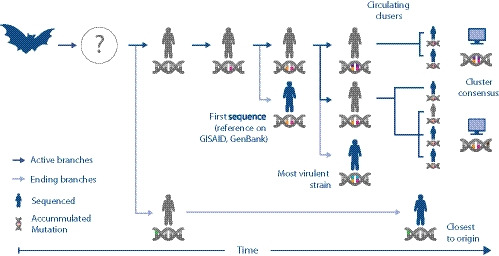FIGURE 1.

Illustration of coronavirus spread while it accumulates mutations. The dark blue arrows represent the main volume of transmissions, while the nucleic acid symbol illustrates mutations acquired by the different viral strains as they enter humans from a primary/reservoir host (represented by the bat symbol) through an intermediate host (which is yet to be identified for SARS‐CoV‐2). The first human SARS‐CoV‐2 isolate sequenced (with orange and pink mutation) may not have been the original strain that first infected humans (grey). It is possible that a strain sequenced later (green) may be genetically closer to the original strain. In this scenario, the original strain has not been captured through sequencing at all. It also shows that there may be two currently circulating strains (orange‐pink‐purple and orange‐pink‐brown), which in turn might be different from the most virulent one (orange‐pink‐blue). In the absence of clinical data correlated with SARS‐CoV‐2 genome isolates, bioinformatic analysis (represented by the computer symbol) can identify clusters and consensus sequences to investigate the genetic diversity of the emerging SARS‐CoV‐2 strains
